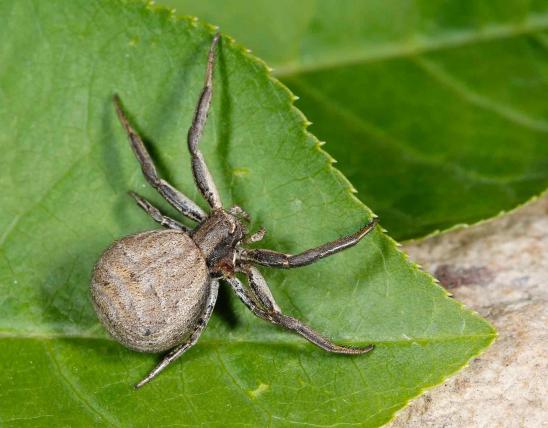
The goldenrod crab spider is often confused with other crab spiders. This species has some capacity to change color from white to yellow, depending upon the blossom it is inhabiting. The female often has an orange or reddish stripe running along each side of the abdomen, extending from the front to about halfway down the side.
The female has a white or yellow carapace, darkening somewhat toward the edges, without spines. The eye region can be marked red, as the yellow-white abdomen often is, with two separate stripes extending midway around the perimeter of the abdomen. Three small spines are found on the first pair of legs, all of which are light-colored.
Goldenrod crab spider males are much smaller but are spectacularly colored with purple forelegs and green-yellow carapace.
Length (not including legs): females ¼ to ⅜ inch; males to about ⅛ inch

Statewide.
Habitat and Conservation
This species is thought to be slightly less abundant than the similar whitebanded flower spider, but it is commonly seen in yellow or white flower heads. It is mostly found in prairies, flower fields, and mixed grasslands.
Food
Crab spiders don't use webs to capture their prey; instead, they hide in flowers and wait for insects to fly or crawl to them. Crab spiders often look like part of the flowers they inhabit. Unlike spiders that spin webs, crab spiders have good vision. When a bee, fly, or other prey species lands on the flower seeking nectar, the crab spider attacks, injects venom into the prey, then holds it while drinking its juices.
Life Cycle
As a general rule, spiders in our area hatch from eggs in spring and spend the growing season eating, maturing, mating, and laying eggs. Females continue creating egg cases as long as the weather holds out. As temperatures cool in fall, their metabolism slows, and they generally die when it freezes. Egg cases overwinter, and spiderlings hatch in spring.
Human Connections
Humans tend to think of pollinators as "good," so it is natural to view their predators as "bad." However, the pressure that predators impose on their prey causes those species, over many generations, to possess quick reflexes, a strong capacity for flight, and good vision of their own.
Ecosystem Connections
Predators, including these small spiders, control the numbers of the species they prey on, helping to maintaining the balance of nature. Spiders, including their eggs and young, provide food for other predators, including other spiders.


























